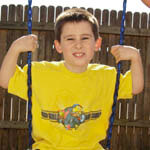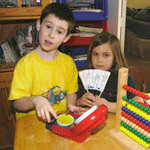
San Antonio (Feb. 9, 2004) – A San Antonio researcher who studies the orderly – and sometimes not so orderly – process by which the body kills its own cells was awarded The University of Texas Health Science Center at San Antonio’s top honor Jan. 29.
Brian Herman, Ph.D., professor and chairman of cellular and structural biology at the Health Science Center, received the 2004 Presidential Distinguished Scholar Award from Health Science Center President Francisco G. Cigarroa, M.D. Dr. Herman’s contributions to scientists’ understanding of apoptosis, or cell “suicide,” has had major implications in the fields of aging, heart disease, cancer and neurodegenerative disorders.
Scientists estimate that 100,000 of our cells die every second and are replaced by new cells. “It turns out a number of different diseases are due to defects in the process by which cells die,” Dr. Herman said. “Our research has implications for how aberrations in the cell death process are involved in the development of cancer and possibly the resistance of cancer cells to chemotherapy and other treatments. We also study how changes in the regulation of the cell death process may contribute to the rate at which we age and/or how well we age.”
Dr. Herman’s research teams and collaborators at the University of North Carolina, Chapel Hill, and the Mayo Clinic have made a number of major discoveries in his roughly 30-year career. They uncovered a process by which cells are injured when they lose oxygen due to loss of blood supply. They also discovered ways to rescue those cells from the injury or slow the injury process. “This has turned out to have major implications for the storage of organs for transplantation and also for treating people who have had heart attacks,” Dr. Herman said.
More recently, Dr. Herman’s work on aging has resulted in preliminary data that suggest deregulation of certain parts of the cell death pathway may play a major role in the development of neurodegenerative diseases and aging. His team is currently employing experimental models that resist the loss of brain cells in regions of the brain that are affected in Parkinson’s disease.
Dr. Herman received his Ph.D. in 1980 from the University of Connecticut Medical School. He joined the Health Science Center faculty in 1998 from the University of North Carolina, Chapel Hill. He has authored 51 book chapters and 148 peer-reviewed publications, many of which have appeared in the top-tier journals such as Nature.
Dr. Herman is chair of the Health Science Center’s Executive Research Committee and is principal investigator of grants totaling more than $8 million. He is the recipient of a prestigious National Institutes of Health MERIT Award, which provides long-term stable support to investigators whose research competence and productivity are distinctly superior and who are likely to continue to perform in an outstanding manner. It is an honor bestowed on only the top 1 percent of scientists in the nation.
Fifteen other Health Science Center faculty and staff were honored with excellence awards. To view photos, bios and video clips of all the winners, visit www.uthscsa.edu/opa/presaward2004/.







